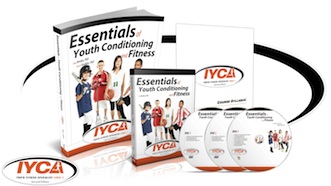Does Your Youth Strength Training Program Promote ACL Injuries?

The good news about knee injuries these days, and Anterior Cruciate Ligament (ACL) tears in particular, is that medical science has turned what used to be a career-ending injury into something most athletes can recover from in time.
The bad news is that ACL tears are occurring more often than ever. Anyone involved in a youth strength training program likely knows at least one athlete who has had a severe knee injury in the past year.
Why do these injuries occur?
The ACL is a small ligament that runs diagonally inside the knee and connects the upper leg (femur) to the main shin bone (tibia). It’s job is to prevent the knee from twisting or moving side-to-side more than just a few degrees. When pushed beyond its relatively small limit, the ACL can either be partially stretched or ripped completely.

In a sports setting, the ACL almost always gets torn during a one-time event. This can occur due to contact with another athlete, or during non-contact moments where the knee may be pushed out of position from a high level of force placed on it. Non-contact situations where this normally happens are during cutting, pivoting, out-of-control stopping, and awkward landings on jumps.
Surprisingly, about 70% of ACL tears in young athletes occur during non-contact events. Female athletes are between 3 and 8 times more likely than males to tear their ACL. Although all youth sports have some level of ACL injuries, soccer and basketball have the most for girls playing sports. For boys, it is football and lacrosse.
With nearly 150,000 tears occurring annually in the United States alone, more focus has not just gone into the rehabilitation process, but also in preventing these injuries from happening in the first place.
How To Prevent ACL Injuries With Your Youth Strength Training Program
One big piece of preventing ACL tears is to focus on both the ankle and hip joints, strange as that may seem. Knees basically go where the ankles and hips send them, so ‘prehabilitation’ measures focus on those areas.
For the ankle, it is crucial that young athletes limit the amount of side-to-side movement that occurs in that joint. Either during one leg standing postures or when running, the more their ankles roll the better the chance it will push their knees either in or out during faster-paced athletic events. Kids who tend to roll their ankles a lot may be much more susceptible to knee injuries when they get bigger, faster and stronger in their later years.
The hip joint needs to both be flexible and strong to function correctly, making it a little harder to train. For the flexibility side, stretches that specifically target the hips may be needed for those with limited ability to do a deep squat. Very young athletes (ages 11 and younger) are almost never in need of these, but once the teenage years approach and growth spurts really kick in, more stretching may be warranted.

Strengthening the hips can be tricky, because most athletes with weak hip muscles have learned to move in a way that shifts the stress to their stronger leg and back muscles. You’d think a basic exercise like a squat would work the hips very well, but not for those who are leg-muscle dominant already. Isolated strength for the hip muscles plus relearning other exercise patterns, such as squatting, must both be done to stabilize and protect the knees.
Just as important in this equation is for young athletes to learn how to move properly. Being able to efficiently absorb the force of gravity when landing on a jump can lower your ACL tear risk substantially, and is relatively easy to learn for most focused and dedicated athletes. In addition, controlling momentum during stopping and cutting movements will further decrease your risk. These skills tend to take much more repetition to improve on, but it certainly can be done.
Although it is true that the younger someone starts improving these skills the better chance it will lower their future injury risk, it is never too late to build the strength, flexibility and movement skill required in sports with a great youth strength training program to keep your knees stable and safe.
Help young athletes train the RIGHT way, perform to their full potential and learn from the very best in industry by getting your IYCA Youth Fitness Specialist Certification today!
SOURCES: British Association of Sports Medicine, www.livestrong.com
